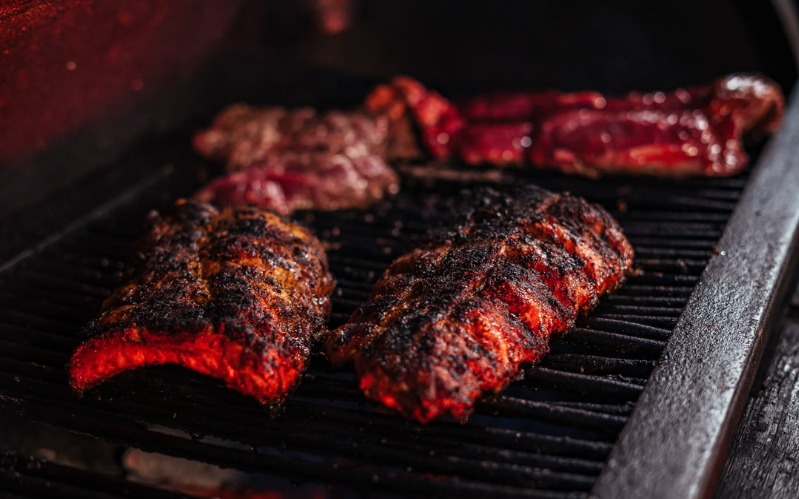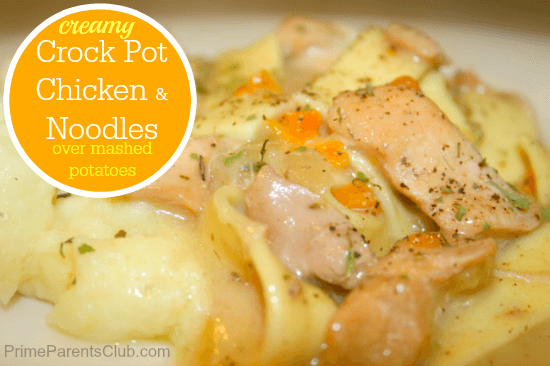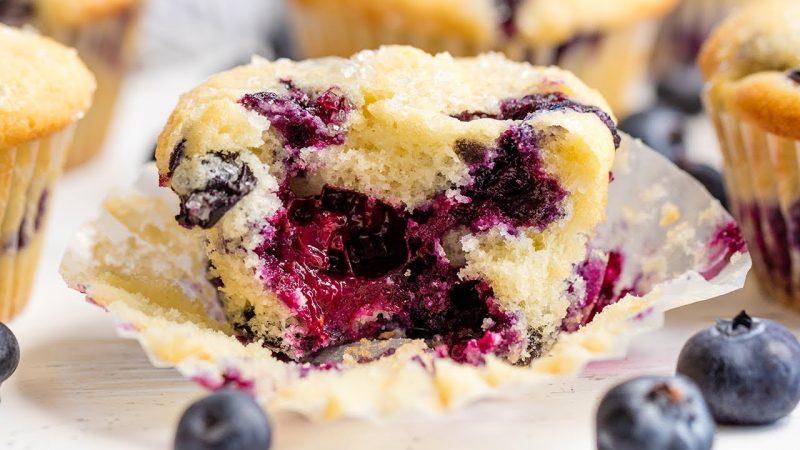How do you Cook Ribs on a Charcoal Grill?
Contents
We barbecue beef ribs on a charcoal grill with the indirect cooking method. This means that the ribs are placed along side, and never directly over, the fire. The heat is kept low, and the ribs cooked slowly. Patience pays big dividends! All to attain that incredible smoke flavor and the moist, cooked to perfection result that alludes so many!

My husband believes that “Barbecue is the Mystical Communion of Fire, Smoke and Meat“.
Stuff you’ll need for this beef rib recipe
Patience The real secret is the beef ribs cooking temp. Maintain a low heat (225-250°F/107-121°C) for an extended cooking period. This is not fast, but the best way to get them tender! You’ll need a full bucket load of this virtue when cooking ribs on a charcoal grill. Figure about 1.5 hours/pound.
Meat Try to buy fresh! Beef ribs are generally sold as “Back Ribs”, in a plastic vacuum pack, by the slab with 7 ribs. “Select” grade (or better) works just fine.
Spices Fresh, top quality spices make a lot of difference.
Charcoal Grill The bigger, the better! Especially if you plan on cooking for a large group. But a smaller kettle type grill (our very favorite is the Weber), or a sturdy classic horizontal charcoal grill, will work great. Be certain you have plenty of charcoal for the duration!
Charcoal/charcoal briquettes There are advantages to both fuels, however just one maxim applies to both…buy the best you can find. Kingsford brand briquettes top the list for quality, and availability. But please don’t buy the “instant light” of any brand! Real charcoal (for you purists) can be difficult to find, and rather expensive, however…
We have found a great resource, restaurant grade, reasonably priced, from Fogo. Their 35 lb. bag of premium lump charcoal is a bargain.
Hardwood chunks/chips Use only hardwood for barbecue ribs like Hickory, Oak, Mesquite, Cherry, Apple, Pecan, etc. (or a combination), to your taste.
Metal pan Filled with at least 1/2″ of water, placed under the cooking rack below the ribs, and used to control the inevitable flare-ups, distribute the heat more evenly, and provide some moisture.
Chimney-type charcoal starter Not mandatory, but sure makes starting and maintaining the coals much easier. Our favorite top performer is the Weber Rapidfire Chimney Starter. Lot of chimney starters out there, but this is the champ.
Mop tool For basting barbecue ribs, you really want a mop…just a miniature version (12-18″ long) of a string-mop you might have for cleaning the kitchen! For ease of cleaning, and long reach, we prefer this Sauce Mop with Removable Head.
Oven/Grill thermometer It’s critical that you know what’s going on inside the grill! For exceptional accuracy, we use and trust the CDN High Heat Oven Thermometer, and the Admetior Kitchen Oven Thermometer.
Tongs You need a good pair of tongs to handle those ribs. We want them long and strong, so we suggest the Weber Style Professional Grade Chef’s Tongs, or the Oxo Good Grips 16-Inch Locking Tongs.
Rib Rack This tool is the answer to cooking ribs with limited grill space! You need one that is strong enough to hold the ribs upright, and regardless of price, few do. We found one that fits the bill with Steven Raichlen’s Ultimate Rib Rack. A little pricey, but it works great!
Let’s talk meat
Barbecue beef ribs usually are sold in slabs of several ribs, sealed in a plastic vacuum-pack, or fresh slabs at the butcher counter. Fresh is always better, but either way, our barbecue beef rib recipe will work wonders.
Now, let’s prepare the meat…
NOTE: Ribs should be always kept in the refrigerator (approx. 40°F/4.4°C) before preparation.
- Take the meat out of the refrigerator about an hour before preparation. This makes it easier to work with. You can do the meat, rub and mop preparation the day before to make it a lot easier when “the gang” shows up.
- Rinse in cold water.
- Remove any excess fat and extraneous meat pieces, or stuff you don’t want to eat. Never touch the fat between the bones. This provides the flavor and moisture needed for great barbecue ribs. Just remove the excess fat surrounding the good stuff.
- Remove the membrane (on inner side). We feel this is a must when you barbecue beef ribs, as it allows the smoke and rub to penetrate the meat more thoroughly. For this chore we have used all kinds of blunt, “pokey” things like a “Phillips”-type screwdriver, a dull knife, or something similar. Lift the membrane until you can get a grip on it this slippery devil (we use a paper towel), and pull it all off.
- Rinse again, pat dry with a paper towel.
A great beef rib recipe starts with a rub!
The ribs are first “rubbed” with a simple, dry, spice-accented rub recipe. All for that unforgettable tender, perfectly seasoned, eating experience!
Basic Barbecue Beef Rib Rub Recipe
Mix together thoroughly the following:
- 1/4 cup dark brown sugar (packed). We prefer “turbinado” sugar for ease of use, and a higher caramelization temperature. But either will work fine.
- 1/4 cup coarse Kosher or sea salt.
- 1/4 cup chili powder
- 3 tblsp ground pepper (fresh peppercorns recently ground!)
- 1 tblsp garlic powder (not garlic salt)
- 1 tsp cayenne pepper (no, it will not be “hot”)
This recipe is enough for 3 to 4 racks of ribs and can be stored in an airtight container in the refrigerator for up to 4 months.
If you wish, to maximize the flavor, apply the rub a few hours (up to a day) before cooking time. Just wrap the ribs in plastic-wrap, or a covered glass/plastic container, and put them into the refrigerator.
Prepare a Barbecue Beef Rib Mop
Our barbecue beef rib recipe includes a mop (basting sauce).A long time favorite with many experienced rib cookers (and we’ve learned to love it) is to frequently apply a mop (baste sauce), during the cooking cycle, to flavor and keep the meat moist. Mops are usually a watery mixture of vinegar, water, and spices, applied with a basting “mop”.
Notice the spices in the basting sauce are similar to the rub? You want to compliment the flavors of your rub, and it is OK to use just the basic spices of the rub (with vinegar and water). Experiment and have fun!
Here is a simple barbecue beef rib recipe favorite:
- 1/2 cup water
- 1/2 cup apple cider vinegar
- 1/2 cup Worcestershire sauce
- 1/4 cup olive or peanut oil
- 1 tablespoon garlic powder
- 1 tablespoon chili powder
- 1 tsp cayenne
Mix well in a bowl, to be applied with a mop tool. When you use the mop tool, stir each time before mopping. Never save mop sauce left in the bowl (it is tainted with the meat’s raw juices). Otherwise the sauce will last a long time in the refrigerator.
For our barbecue beef rib recipe we…
- Slather the meat with a thin coat of any common yellow table mustard (not mandatory but a cool method many top contenders use) when applying a dry rub. This will not impart a mustard flavor as that cooks out) but holds the spices close to the ribs, keeps the meat moist, does not block the smoke and leaves a nice seasoned coating.
- Sprinkle the rub on the ribs, and if you chose not to use the mustard, rub it on the meat. Dads, for a good barbecue beef rib recipe, do not over season (moms rarely do). Learn this lesson when cooking barbecue beef ribs; a light application is sufficient!
Get the Grill Ready
NOTE: Please, do not use charcoal lighter fluid. There are several good “fire-starters” on the market that will not taint the meat, or impart potentially dangerous chemicals to the food.
- Fire-up the charcoal…we like the chimney-type charcoal starter because it’s the quickest, and easiest, way to start the coals. To barbecue ribs on a charcoal grill you’ll need to replenish the coals occasionally, to maintain the ideal temperature of around 200-225°F (93-107°C), and the chimney makes this chore painless.
- Start with about 60 briquettes. Let them get a to white/gray color and they will be ready for the grill. You will need to fire-up some more coals (about 8, or so), several times during the cooking cycle, to maintain the temperature. Closely monitor the temperature and anticipate this with about a 15-minute lead.
- To barbecue beef ribs on a charcoal grill, you control the temperature with the bottom/side vents on your grill. Adjust the top vent to half open, and leave it alone.
- Put a big ol’ handful of hardwood chips or chunks (pre-soaked in water for about an hour) on the coals. Now, close the grill and let the smoke get started. This will be the last time, during the cooking cycle, you will have anything to do with the smoke. Too much smoke makes the meat bitter tasting and smoking is actually done in the first couple of hours.
- Place a pan about 2/3 full of hot water (no sense wasting fuel to heat the water), under the meat side of the grill, to provide moisture and catch the drippings.
Cook ‘Em
- Place the ribs on the grill, opposite side of the fire, bone side down, to begin cooking. Avoid the ribs touching. When cooking beef ribs on a charcoal grill, never let the meat overlap the fire. You cannot undo crispy or burnt barbecue beef ribs! Close the lid and…
- Resist peeking! You’re loosing precious heat. Open the lid only far enough to do the job. Check the ribs for the first time in about 15-20 minutes to make sure the temperature is holding at around 200°F (93°C), and then check about every half hour to mop and turn ’em over to prevent “the singe”. Mop should be applied lightly, and sparingly.
- You have time! If you have judiciously maintained the cooking temperature, peeked, mopped and turned the ribs after about 3 hours, you can leave your station several times before the ribs are done. When the meat starts to pull away from the end of the bones, use the tongs to wiggle a rib to test. Meat should be tender, and loose from the bone, when done.
- Our barbecue beef rib recipe provides a wonderful, natural flavor, so we emphasize the need to season lightly. If you wish you can now bring out your favorite BBQ sauce, and baste during the last half hour of cooking. We do not barbecue beef ribs on a charcoal grill with barbecue sauce, as this interferes with the smoke absorption, and there goes your fame!
- Wrap in aluminum foil, place in a brown paper bag and set aside if you cannot serve them immediately. This gives you some time to get the meal together and really helps make the meat tender!
Serve Em!
Warm, cut individually taste, eat ’em just as they are. Many folks like a “finishing sauce”. This is nothing more than a barbecue sauce, of your choice, served as a side dish (or two), for the folks who would like to put something more on their ribs. Lets eat!
Bonus: Dry Rub Recipes for Smoked Brisket
You’ll love these dry rub recipes for smoked brisket, Texas-style. They are very easy to make, and deliver tons of flavor to ensure your pit-master fame!
You can store these rubs in an air-tight container, in the refrigerator or freezer, for weeks.
Texas-Style Brisket Rub
This recipe is sufficient for a 10-12 lb./4.5-5.4 kg beef brisket.
Mix together thoroughly the following:
- 1/2 cup paprika
- 1/4 cup Kosher salt
- 1/4 cup sugar
- 1/4 cup brown sugar
- 1/4 cup cumin
- 1/4 cup chili powder
- 1/4 cup fresh cracked black pepper
- 2 tablespoon cayenne pepper
Rub your brisket thoroughly, barbecue, and receive endless accolades.
Traditional Texas Brisket Rub
This recipe is for a 5-6 lb./2.3-2.7 kg beef brisket.
Mix together thoroughly the following:
- 2 tablespoon freshly ground black pepper
- 1 tablespoon kosher salt or sea salt
- 1 tablespoon chili powder
- 1 tsp garlic powder
- 1 tsp onion powder
- 1 tsp dried parsley
- 1 tsp oregano
- 1 tsp sugar
Chuckwagon Texas Brisket Rub
This recipe is for a 5-6 lb./2.3-2.7 kg beef brisket.
Mix together thoroughly the following:
- 1 tablespoon coarse salt (kosher or sea)
- 1 tablespoon chili powder
- 2 teaspoons sugar
- 1 teaspoon freshly ground black pepper
- 1 teaspoon ground cumin
























